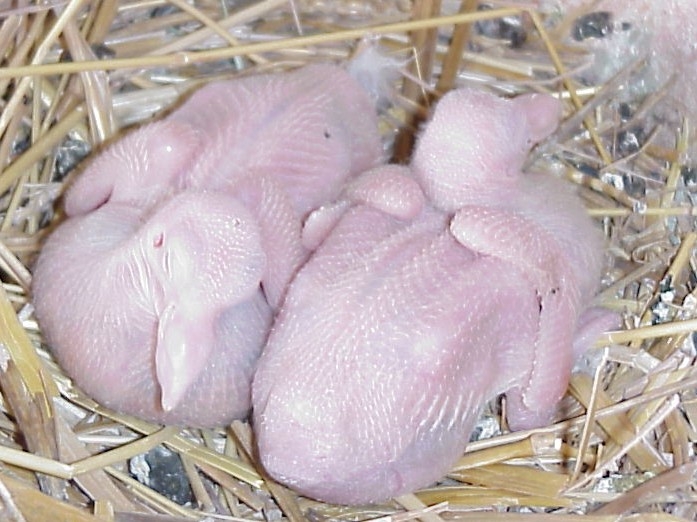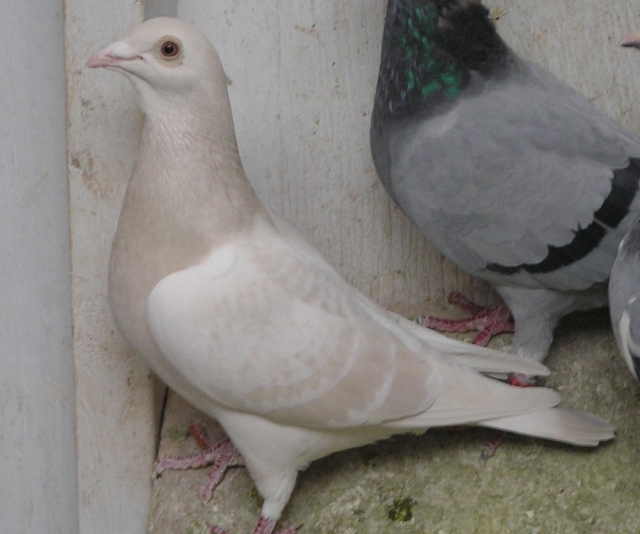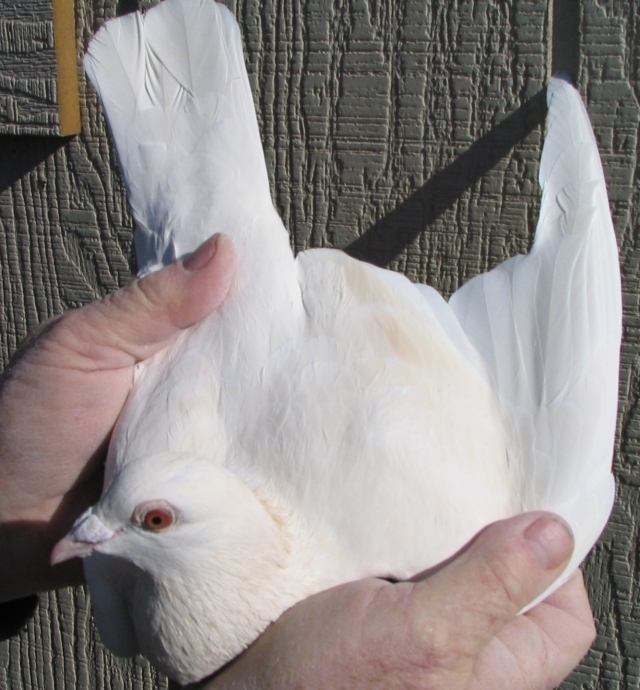The following is taken from an article jointly authored by Larry Davis and myself. It describes our study of Jack Barkel's Lemon mutation in an effort to determine its genetic characteristics. This article was published in the Purebred Pigeon, May/June 2007 issue. It is republished here with some revisions and updates added.
Lemon
Described In 1968 - Not Seen Until 1997
genetically classified as extreme dilute
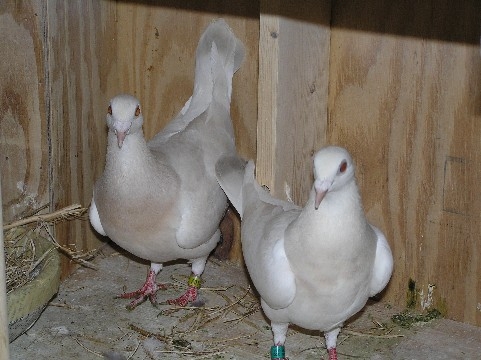
Two Lemons which genetically are Extreme Dilute Blues, photo by Larry Davis
|
It’s a rare occurrence when someone predicts something will happen especially when it’s not known to exist yet, and later that very prediction comes to pass. Well that’s the case with this new mutation know as Extreme Dilute, it was described and predicted in 1968 and came to pass in 1997. The late Dr. Willard F. Hollander in his book Origins and Excursions in Pigeon Genetics page 81 points out that in 1912 a Mr. R.M. Strong reported sex-linkage of white color in ring-doves (Biological Bulletin vol. 23, pages 293-320); Hollander then goes on to say ….. “Actually the white dove has some pigment and would better fit the name “extreme dilute”. Like dilute pigeon squabs, baby white doves have very short nestling down.”………… On page 82 Hollander went on to make the following prediction ……..”Sooner or later an extreme-dilute mutation should pop up in the pigeon, like the white of ring-dove”……….. Please note that Dr. Hollander or Doc as his many pigeon friends affectionately called him did not say this mutation would produce a pure white pigeon or what we would call a white phenotype. On the contrary, Doc said extreme dilute would express some pigment. OK let’s talk about that for a moment. Have you ever noticed the wild type color of Ring-Doves is a dark tan and not the wild type blue seen in pigeons even though both colors result from black pigment? One might ask why that is so. Well there are a number of things some of which differ within each species that do come into play in determining their final color. These differences result in the ring dove being seen as dark tan, while our domestic pigeon appears as a bluish gray. That being the case, it naturally follows that mutations such as dilute will therefore result in similar differences in their respective dilution phenotypes. In ring-doves, dilute produces a blond phenotype while the dilute mutation in pigeons produces a silver dun color. Knowing this, it should not come as a surprise that other mutations at this very same dilute locus will also result in similar differences between the two species, i.e. extreme dilute would not display exactly the same way in ring-doves and pigeons. Since ring-doves start at a lighter shade than pigeons, they logically should also display both their dilute and extreme dilute phenotypes in lighter shades than pigeons. This poses a very interesting question. What results if extreme dilute is found in both species and both species happen to have the same color such as the black wing pattern markings (pigeons) or a black neck ring (doves)? Answer: for extreme dilute the color is the same. The typical black feathers becomes a very light golden cream or light beige color almost identical to what we see in the neck ring found on ring-doves and the wing checker pattern markings of the new color find in 1997 by Jack Barkel which he calls “Lemons”. We know from his own writings that Doc recognized dilute white doves were not truly white. That some pigment is present and that some day something similar would occur in pigeons. It’s our opinion (Larry Davis, and Ron Huntley) that this has indeed happened just as Hollander predicted. In other words, Jack Barkel’s new color find which he named as Lemons are genetically extreme-dilutes. Now it takes more than a gut feel for something to be a fact, so let’s go over the data, examine the way it was collected and see if this conclusion has merit. I guess the best place to begin would be a short review of the new lemon color or mutation. What is it and where did it come from are the obvious questions that come to mind. The answers to those questions are found in Jack Barkel’s book “The Hidden Mysteries of Nature and Science” As applied to the aspect of racing and breeding pigeons, by Jack Barkel, 2001, ISBN-9960-39-564-2. Jack, as many of you know, is a lecturer on pigeons and eye sign theory. In his travels both in South Africa and abroad he has seen and examined many, many pigeons. While on one of his lecturing trips to Kimberly SA Jack encountered a hen of the Slimme line which was of an unusual light color, one that he had never before encountered. Not only was Jack taken by this new color but he was equally impressed by the bird’s eye and after some persuasion was able to procure the bird. Jack’s plan was to create another strain of racing homer; using this bird’s unique color and eye sign as its base. He spent the next several years developing a colony of Slimmes of this color, both cocks and hens. Originally he called them Barkel’s Biscuits but on the 29th of August 2001 he announced to the pigeon world in his new book that the official name would be “Barkel’s Lemon” and went on to say they were born without yellow down showing their rather pale pink skin.
Lemon youngsters photo by Jack Barkel Basically
lemons are a very light golden cream or light tan color as seen from
the next photo.
Blue Check Lemons Hen, photo by Larry Davis Since the original three birds were checker pattern, most of the lemon birds seen today are also of that same checker pattern but as more birds are crossed in other patterns will naturally follow. However, since this mutation is of such an extreme dilution factor, pattern markings, at times, can barely be discerned. Believe it or not but the bird below is of the checker pattern as are the two birds at the beginning of this article. Lemon or Extreme Dilute, this one known to be of ash red origin. Note the lighter color and missing tail bar. In early May 2002 a consignment of 54 birds left South Africa destined for the US. Of these 54 birds 4 were lemon cocks (homozygous extreme dilute), 4 were lemon hens (hemizygous extreme dilute), and at least 3 were blue check cocks heterozygous for extreme dilute. These 11 birds were destined for 5 different lofts |
with one lemon pair going to one loft, 3 lemon cocks each going to separate lofts and the remaining 6, 3 heterozygous cocks and 3 lemon hens, all going to the fifth loft. Many of these 11 birds were destined to be the "seed stock" for the research into extreme dilute in the US and formed the first importation into the US of this new mutation. Unfortunately these birds were held in transit and quarantine until very late in 2002 and when delivered were in very rough condition it was reported. The loft receiving the largest number from this shipment reported that the majority could not be successfully bred until relatively late in 2003 due to the condition problems as well as becoming acclimated to the northern hemisphere. Genetic testing became organized in South Africa in early 2004 by a group of like minded fanciers on the South Africa Pigeon Mailing List or SAPML for short. Larry Davis was one of these fanciers but since no Lemon birds had been acquired by him yet, Larry was limited to an advisory role for the group, the majority of which had little to no genetic experience. Larry’s genetic experience was exactly what they needed to get the ball rolling and Dr. Win Peters a South Africa veterinarian asked Larry to take that roll which he gladly did. Now in case your not well versed in genetics, let me point out, there are certain basic principles which must be rigidly followed when collecting data. One of these is good record keeping and another is controlled breeding tests where there can be no question of who the sire and dam are. Another rule is keep it simple so that nothing is added that will cloud the issue and confuse the outcome. It was apparent from the get go that some of these rules were not being followed as conflicting data was being submitted to the group. To over come this Davis set out some basic guidelines emphasizing the need for isolation breeding pens and good record keeping. He laid out some controlled breeding tests to be conducted and evaluated their outcomes. The early findings seemed to indicate that this was a sex-linked recessive mutation. Now there really aren’t very many possibilities in this regard as every gene is either a sex-linked gene meaning it’s located on the Z or sex chromosome or it is not a sex-linked gene; making it an autosomal gene found on one of the 40 some pairs of autosomal chromosomes. In other words, either it is or it isn’t sex-linked and if its not sex-linked then it must be an autosomal gene on an autosomal chromosome. In a similar fashion, a gene is either recessive or dominant in nature. If dominant then it will show it’s presence regardless if it is heterozygous meaning split for the effect or homozygous meaning pure. The easy thing to remember is that a recessive gene will not express when there is a more dominant allele (alternative) present. Historic data from South Africa lead to the hypothesis that lemon was most likely a sex-linked mutation based upon sex ratios and numbers in the initial breeding data. So the two basic questions before the group were, is it sex-linked or not; and is it a dominant or a recessive? Larry’s prescribed breeding tests gave them the answers. Using Larry’s guidelines, the pairing of lemon hens with the un-related blue cocks the youngsters produced were all blues of both sexes. However, when breeding their blue sons to their blue sisters or to other un-related blue hens, some lemon youngsters could be produced and these were always hens; all of the remaining youngsters being blue of both sexes. In addition, when breeding the blue sons to lemon hens, both blue and lemon young of either sex were produced. This clearly indicated that the mutation was both sex-linked and recessive. In other words, it seemed to follow precisely the same rules that govern both dilute and or reduced birds which are also the result of sex-linked recessive genes. Also when pairings were made with lemon cocks to unrelated blue hens all of the daughters were lemon in color while all the sons were blues. This would not be possible if this recessive mutation were autosomal. If this lemon expression were the result of an autosomal factor, distribution of the phenotypic lemon expression should have approached a 50/50 sex ratio which it did not. That strongly points to it not being an autosomal genetic trait. Additional test mating were still needed to achieve the numbers necessary for positive confirmation but there was more than enough data there to give Larry and the group a strong indication of what they were dealing with. Now the big question was “is this a new color or is it a new color modifier like dilute and reduced. On the morning of 5/13/04 there was a posting on the SAPML by Dr. Peters informing the group that a brown cock to a lemon hen had produced brown daughters and blue sons. Independent US sources conducting similar lemon testing yielded these vary same results. To the average flyer that would seem unimportant but to the armature geneticist like Davis it was a very significant find. Many had assumed lemon was a phase of brown while others believed it to be a new pigment. Dr. Peters posting both eliminated lemon from being a phase of brown or a new pigment color like brown, blue/black or ash red. The lemons were breeding as blues. In other words, it was not a new phase of brown or a mutation at the b locus. Davis then concluded he was either dealing with a new pigment reducing mutation at a new locus on the Z chromosome or a new allele at one of the existing loci on this chromosome such as the dilute or reduced loci. In May 2005 Davis attempted to demonstrate where on the sex chromosome this gene may be located. To do this he choose a lemon cock, which by this time had been determined genetically to be a blue and paired him to an ash yellow hen. Since this was a sex-linked mating (blue cock x ash red hen) he knew the sexing of the young could be determined by their color while still in the nest. Because we already understand the workings of a sex-linked pairing and what these results should be; this very useful knowledge then presents us with three possibilities:
It was the second possibility that occurred. Two consecutive nests produced a blue lemon hen and an ash yellow cock. In addition, this also demonstrated that dilute was dominant to this new mutation making it the third allele in the dilute series at the d locus. The resulting progeny from the above breeding tests and those from 2004 were handed out both locally and to others mainly at the Louisville National Young Bird Show (NYBS) in October 2005. That year, at the NYBS the test pairings and their findings were discussed in detail with several genetic knowledgeable fanciers, including those new "lemon owners". Larry was convinced that the fastest way to generate more data was to freely distribute lemon birds to other genetic minded breeders. He felt if he could get them involved they would be a tremendous asset in generating more solid data and help to document lemon crossover phenotypes with both ash red and brown should either occur. The more duplicating results at differing locations the better. 2006 saw many more being handed out to yet more fanciers in order that more enthusiasts could become involved. This
he did and now the quest is on to unravel the secrets of this new
sex-linked, recessive Other fanciers are doing the same around the country, some to produce new color phenotypes and other to move extreme dilute into other pigeon breeds. As Dr. W. Hollander had predicted we had found a new "extreme-dilute mutant" at the d locus. And as he had predicted it caused a phenotype that, at least for the first couple weeks of it's life, is so de-pigmented as to appear near white with pink eyes. In summation,we now know that what was up until this point referred to as lemon by most, is a sex-linked recessive at the d locus and is recessive to both pale and dilute. Genetically it functions as an extreme form of dilution and therefore should, as one of the alleles at that locus, be know as "extreme dilute" and symbolized as dex. What started a few years ago with just a few fanciers and a handful of birds has grown to the point where there are dozens of fanciers all over the country breeding extreme dilutes and many are transferring this new modifier into their favorite breeds and at the same time generating volumes of additional data. Authored by Larry Davis and Ronald Huntley for original publication in the Purebred Pigeon, May/June 2007 issue. |
Some additional photos not included in the article.
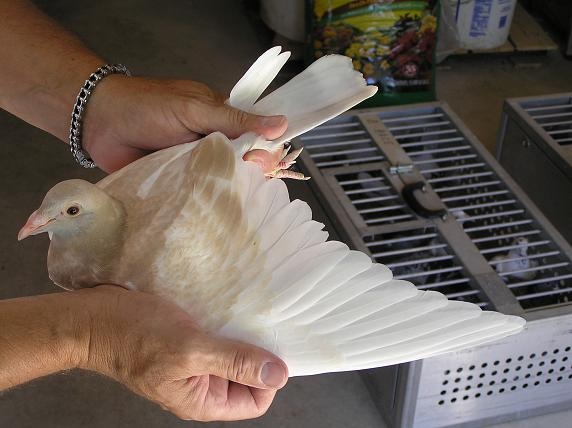
Young ash yellow cock split for lemon, bred by Larry Davis. Young ash red check lemon (Beige) hen, bred by RonHuntley.
The phenotype name for an ash red extreme dilute is Beige as per Ronald Huntley.
The phenotype name for a blue extreme dilute is Lemon as per Jack Barkel.
The phenotype name for a brown extreme dilute is Tan as per Ronald Huntley.
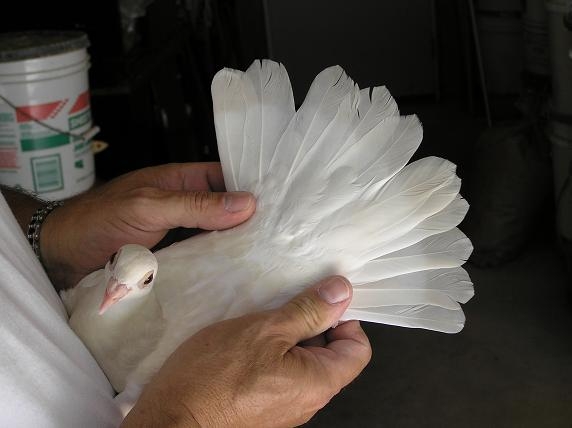
Please note: While the brown phenotype for extreme dilute is darker in color than either the blue or ash red phenotypes of extreme dilute; it is still lighter in color than either the dilute, pale or normal intense phenotypes for the color of brown.
![]()
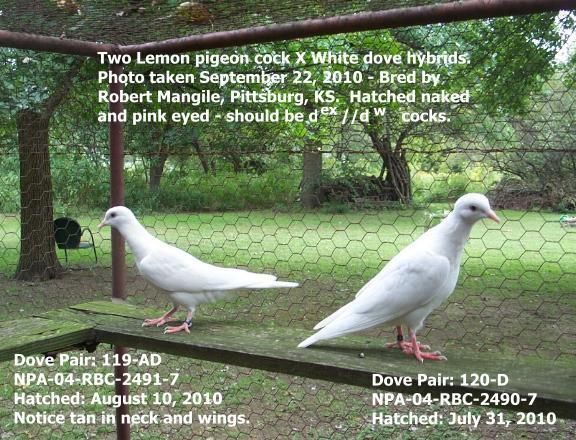
![]()
The following report highlights Larry Davis's personal involvement in his study of a new mutation for extreme dilute. It is writen by him in his own words.
Ronald
Huntley
Extreme
Dilute - Chapter 1
Early in 2004, February and March I first became aware of a new
coloration in
racing pigeons in
Early reports were that many more hens than cocks were being produced
even
under controlled conditions. These folks were mainly racers without
extensive
background in genetics in general or pigeon genetics in particular.
With the general numbers relative to sex vs. color ratios that were
being reported
one doesn't have to have a PhD in population genetics to take notice
that sex
linkage was the probable explanation.
The
gene had already been demonstrated, by
several sources in South Africa, to be a simple recessive. If it had been
autosomal, phenotypic lemon
expression distribution should have approached a 50/50 ratio. Also sources in
As we know the only way for a heterozygous recessive gene to express
the same
as a homozygous is if the heterozygous individual is hemizygous, a hen
and the
gene or mutation under study must be on the Z chromosome. With this in
mind my prime requested pairing
of these two breeders was a lemon cock to a totally unrelated blue hen.
This
would be the logical first pairing to verify sex-linkage.
All of this took place on or before
On the morning of
That evening I received, what I believe was the first communication
from a
Extreme
Dilute - Chapter 2
At
this time it may well be fitting to chronicle the introduction
of extreme dilute into
In early May 2002 a consignment of 54 birds left
What should have been a reasonably straight forward shipment turned out
to be
anything but. Upon leaving
It was from the 2003 and 2004 bred youngsters and their offspring that
almost
all doing research in the
Extreme
Dilute - Chapter 3
Several weeks as well as a few days prior to receiving my first pair of
lemons,
in May 2004, I responded to a series of questions from a pigeon related
email
list (SAPML) regarding the best path to fellow in discovering what this
new
"Lemon" mutation was; and on which chromosome it may be
located. My comments were based on the hypothesis that lemon
had a very
high likelihood of being sex-linked. The
basis for this hypothesis was based on
preliminary findings, mainly from sex-ratios in breeding facilities in
Public posting from
The quickest way to get a good idea if it is a sex linked recessive for
this color
is to mate a Lemon cock to a blue hen (bar or cheque) known not to
carry Lemon. If
it is sex-linked ALL the young cocks will
be blues of some type and ALL the young hens will be Lemon. The best way to
guarantee that the hen
doesn't have a chance of carrying Lemon (if it is not sex-linked, as if
it is
sex-linked she would be a lemon) is pick a hen from another family. I
must comment that from some of your former postings stating that, at
the start
at least, more hens were born than cocks suggests at least sex
linkage. I
personally would love to work with this new
color sometime, it is very interesting. Discovering what it may be an
allele to
is intriguing. Larry
Davis 04/04
Public posting from May 14, 2004 hypothesizing the likelihood of
sex-linkage in
lemon
Right now this will be the most telltale pairing we can make. We already
know/assume a couple of things
from the matings so far. It is not a form of ash red and it is
recessive. This
pairing, Lemon cock to blue hen will tell
us, hopefully immediately, if it is a sex-linked
recessive. If ALL
the hens from this pairing are Lemons and ALL the cocks are blues, then
we have
nailed it down to a sex-linked recessive color modifier as the brown
pairing described
by Dr. Wim seems to have already eliminated the possibility of a new
mutation
at the blue/ash locus.
As lessons continue it will become apparent why the blues must come
from unrelated
families and must be devoid of complicating mutations if at all
possible. Larry
Davis 05/04.
The arrival of my first pair of lemons conveniently came at the end of
my race
team's normal breeding season. So I set about
attempting to prove
or disprove my hypothesis that this was a sex-linked
gene. To
begin the process, I selected a blue cock
from my breeders to mate to the lemon hen and a blue hen to put to the
lemon
cock.
The blue cock to lemon hen produced only blue young of both sexes. The
lemon cock to a totally unrelated blue hen resulted in blue cocks and
lemon
hens.
The results produced from the first pairing would have been the same
whether the
mutation was an autosomal or a sex-linked mutation; so the only thing
demonstrated
was that this new mutation is a recessive to wild type.
The second pairing, however; was more fruitful. It clearly
demonstrated this
mutation when present could be expressed in the heterozygous state for
the
hemizygous sex (hens) thus clearly showing it must be
sex-linked. Had it
been an autosomal the resulting progeny would have all been blues, just
as it
was with the reciprocal mating of the blue cock to a lemon hen.
In December, 2004 I summarized all the known information into another
post for
the SAPML as follows:
Folks, It's time to do a quick over view of what has been
learned so far
on this mutation.
1. Lemon is recessive. Two
lemons paired
always produce only lemons. Two
blues
paired can produce lemon.
2. When two blues produce a lemon it's a hen. This
suggests sex-linkage.
3. A pairing of a lemon cock to a non related blue hen produces, as far
as I can
verify, only blue cocks and Lemon hens. Again sex-linked. If
the
mutation were autosomal the young here would be all blue.
4. A pairing of non-Lemon bred blue cock to a Lemon hen produces all
blues. Lemon
is recessive to blue.
5. One mating of a brown cock to a Lemon hen has produced blue sons. This means that
the Lemon is breeding as a
blue pigeon with a hidden, in the young, diluting gene. This means that
the mutation is not at the
ash red/brown locus.
6. The pairing that was sited of a lemon cock to a non-related brown
hen producing
a Lemon cock I question. This doesn't fit pigeon genetics as we understand it whether the mutation is sex linked or autosomal.
If the mutation is sex linked then ONLY Lemon hens can be produced.
If it's autosomal and the brown hen didn't carry it then NO Lemon young could be produced.
7. If the mutation were autosomal then a pairing of a non-related non-carrying blue hen to a Lemon cock would produce ONLY blues.
Let the discussions begin; this is what has come to light so far. Remember folks that any findings must stand up to "peer review ". All who do the same matings in individual breeding pens need to be able to produce consistent results. Larry Davis 12/04.
New lemon pairings were continued, along with my regular breeding season beginning in December 2004. These new pairings were all conducted with blues which were un-related, non-lemon stock, mainly to reaffirm the previous season's results. In addition they generated more lemon stock for others in our hobby that had expressed an interest in also studying this new mutation.
The same results occurred, lemon hens and blue cocks from the lemon cock to blue hens; and all blues of both sexes from the lemon hen when paired to blue cocks.
In May I attempted to demonstrate where on the sex chromosome this gene may be located. To do this test I choose the lemon cock, which by this time we had already determined genetically to be a blue and paired him to an ash yellow hen.
Since this was a sex-linked mating (blue cock x ash red hen) I knew the sexing of the young in this case could be determined, most likely, at hatching.
This knowledge presented us with three possibilities. First, if the sons were ash reds then this mutation was not at the d locus and that additional testing would have to be conducted to determine its true
location. Secondly, if the sons were ash yellows then neither of their two sex chromosomes would have a wild type allele at the d locus and therefore a dilute phenotype would demonstrate that dilute and the lemon mutation must be alleles. The third possibility would be if the sons were ash lemons then sexing would have to wait until the presence or absence of the tail bar could be ascertained and then later confirming breeding tests could be conducted. This possibility would be if lemon was an allele of and dominant to dilute.
It was the second possibility that occurred. Two consecutive nests produced a blue lemon hen and an ash yellow cock. In addition, this also demonstrated that dilute was dominant to this new mutation making it the third allele in the dilute series at the d locus.
The resulting progeny from the above breeding tests were handed out both locally and to others mainly at the Louisville National Young Bird Show (NYBS) in October 2005. That year, at the NYBS the test pairings and their findings were discussed in detail with several genetic knowledgeable fanciers, including
those new "lemon owners". By freely dispersing this stock and the known data to other competent breeders, I felt it would be a tremendous asset in generating more solid data and helping to document
crossover phenotypes with ash red and lemon should it occur. In other words, our quest to unravel the secrets of this new sex-linked, recessive mutation at the dilute locus would be dramatically enhanced.
The more duplicating results at differing locations, the better.
As Dr. W. Hollander had predicted we had found a new "extreme-dilute mutant" at the d locus. And as he had predicted, it caused a phenotype that, at least for the first couple weeks of it's life, is so de-pigmented as to appear near white with pink eyes. In summation, what up until this point had been referred to as lemon by most, is a sex-linked recessive at the d locus and is recessive to both pale and dilute. Genetically it functions as an extreme form of dilution and therefore should, as one of the alleles at that locus, be know as "extreme dilute" and symbolized as d ex.
Until the next installment.
Larry
Davis
Previous Page - Pale, Dilute and Extreme Dilute
Copyright 2009 by Ronald Huntley.
Permission is granted to download or copy for non-commercial individual
use only.
The author retains all other rights under copyright.
Ronald R. Huntley
Web Page Designer
Duncan SC, 29334
phone: (864) 249-0276
